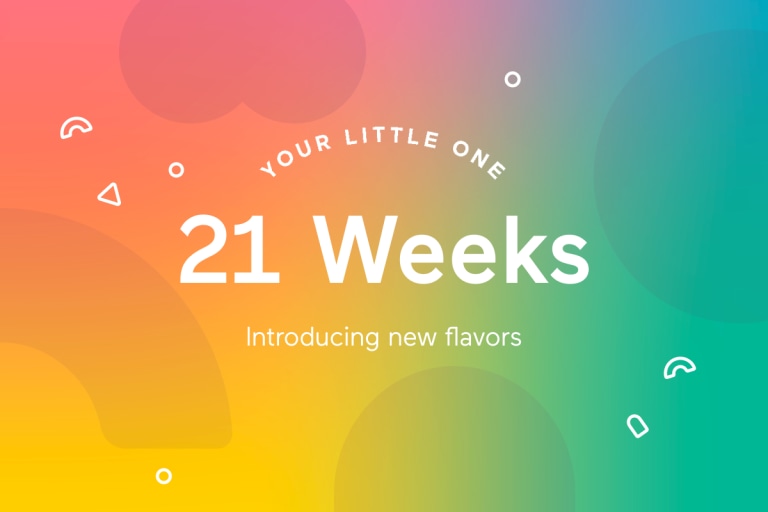Your 21-Week-Old Baby
Food, glorious food! And how to make perfect purees yourself.
Introducing Solids
Clear out your phone’s camera roll now…because those monumental first spoonfuls are going to take up quite a bit of room.
Feeding your baby their first bite of solids is something memorable—especially the expression on your little one’s face as they take their first taste (and tries to understand why you’re making airplane noises). Happy? Confused? Grossed out? All of the above? Get ready to find out!
When introducing new foods, the American Academy of Pediatrics (AAP) recommends exposing your baby to a wide variety of fruits and vegetables and offering a variety of textures, too. Lots of parents start with a single-grain infant cereal, like oatmeal or barley. (Keep in mind there’s no medical evidence that this needs to be your baby’s first food.) Cereals are sold premixed or dry. If you buy a box of dry infant cereal, just add some breastmilk, formula or water to create a liquid consistency that’s easy for your baby to swallow. It shouldn’t be much thicker than milk or formula at this point.
If your baby isn’t into cereal, you may find yourself skipping right along to pureed fruits or veggies. Simple fruits and veggies are a good starting place—bananas and avocados are great first foods (especially since all you need to do is smash a ripe banana or avocado with a fork). Pureed sweet potatoes and carrots are also crowd-pleasers.
Your baby’s first foods may not rock their world as much as all the fun feeding gear they get to play with (spoons, bowls, bibs…can this mealtime thing get any more amazing?!) If they’re crying, not interested or turn their head away from the food, don’t force it. Just go back to your usual bottle or breastfeeding schedule for a few days before trying again.
Give your baby time to get used to this new experience. Start with just a teaspoon or two and slowly build your way up to more food as they get the hang of actually keeping it in their mouth. And remember, there’s no need to stress about the amount of solid food they’re eating. Babies still get the nutrition they need from breast milk and/or formula.
Want more info? Here’s a comprehensive overview on everything you need to start solids.
Hold Off on Honey
Pediatricians advise parents to avoid giving honey (even just a taste!) to babies under the age of one. This recommendation isn’t about allergies or sugar intake—honey may contain spores of bacteria (C. botulinum) that can cause infant botulism. So steer clear of honey until after the first birthday when digestive systems are more mature.
Milestone: Seeing in Full Color
Your baby’s eyesight is constantly evolving. And according to the American Optometric Association, by month five baby has good color vision. So now those bold, bright toys (that are taking over your house) are extra exciting.
Try this: Add some new mobiles to the rotation. Your baby will love chilling in their crib, watching bright shapes move over their head. Or attach colorful toys to the stroller bar (like the beloved Freddie) so baby has “friends” to interact with on walks too.
Making Your Own Baby Food
Baby food jars and pouches certainly come in handy, especially when you’re on the go. But store-bought food can quickly can get expensive. Luckily, it’s a breeze to make your own. Not only does this give you control of the ingredients and quality, but you’ll have fun being creative and seeing your baby delight in your latest combos. And yes, you can totally pat yourself on the back for sneaking in some spinach.
No matter what type of gadget you go with, the process is pretty much the same: prep food, steam, puree or chop, and eat. Keep wipes in arm’s reach, because things are going to get messy!
Want to see how it’s done? Here’s a guide to what you need to know, what foods to make and some flavor combinations. If you’re feeling inspired to puree, check out the baby food makers Babylist parents love.
Babylist Staff
Editor
Babylist editors and writers are parents themselves and have years of experience writing and researching, coming from media outlets like Motherly, the SF Chronicle, the New York Times and the Daily Beast, and the fields of early childhood education and publishing. We research and test hundreds of products, survey real Babylist parents and consult reviews in order to recommend the best products and gear for your growing family.

